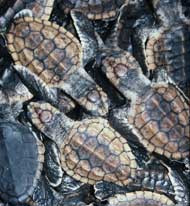![]()

Loggerhead turtle hatchlings (Photo courtesy Dr. Kenneth J. Lohmann)
Home Page
and index of current stories
Older stories on Resources News
Links to general resource, environmental sites
Links to non-profit environmental/resource groups
Links to environmental/resource news sources
E-mail Resources News
Sea Turtles have Built-in Compass
Research shows baby loggerhead turtles use Earth's magnetic field to navigate.
Long distance wildlife migrations continue to fascinate both professionals and amateur nature lovers alike. The basic question for both groups is "How do they do it - how do they navigate?" Research over the past few decades has suggested that earth's magnetic field, the force that makes a compass work, is used by many bird species. It's also likely that that sea turtles also navigate by using the earth's magnetic field.
Working in Florida, scientists have found what they believe is the strongest evidence yet that baby loggerhead turtles "read" the Earth's magnetic field to help them navigate the massive clockwise current that sweeps the northern Atlantic Ocean.
Built into the humble creatures' genes is a remarkable ability to monitor global magnetism and to recognize magnetic fields that mark geographic regions where the turtles must change direction to stay on course. The mechanism is not infallible, the University of North Carolina at Chapel Hill researchers say, and some hatchlings perish off track in colder waters, but it appears to operate for most of them most of the time.
"To me, one of the great wonders of the world is that baby sea turtles enter the ocean and then swim across the Atlantic and back all by themselves," said Dr. Kenneth J. Lohmann, associate professor of biology. "People have wondered for years how young turtles navigate during that first migration because it seems utterly impossible.
"How can they find their way along an 8,000-mile migratory route that they've never before encountered? We're finally on the verge of understanding how they do it."
Florida loggerheads' migratory path follows an enormous circular current system known as the North Atlantic gyre. Water in the gyre is relatively warm, and food is abundant. But outside the gyre, conditions are less favorable, and turtles that stray from the route often die from the cold.
To determine whether loggerhead hatchlings could distinguish among magnetic fields found in different parts of the gyre, the biologists fashioned tiny bathing suits for the animals that were tethered by a fishing line to a lightweight mechanical arm that swung in the direction the turtles swam. The creatures, which were later released unharmed into the ocean, did not notice that they weren't making progress.
Researchers tested the turtles, which had never been at sea before, in a saltwater-filled, fiberglass pool surrounded by a computerized coil system. The coil produced magnetic fields closely resembling those found in different locations along the migratory route.
When exposed to a magnetic field like the one that exists in northern Florida, most of the reptiles swam eastward, a direction that would carry them out to the north-flowing Gulf Stream. When exposed to a field found off the coast of northern Spain, most turned south. And when subjected to magnetism like that at the southern edge of the North Atlantic gyre between Africa and South America, most headed northwest, a direction that would send them homeward to the U.S. coast.
"Our results provide direct evidence that young sea turtles can in effect exploit regional magnetic fields as open-ocean navigational markers," Lohmann wrote. "The turtles emerge from their nests ready to respond to specific fields with directed movements. These responses are appropriate for keeping young turtles within the gyre system and facilitating movement along the migratory route.
Interested in learning more about sea turtle migration - or learning about other sea creatures? Visit the Ocean Web site of the University of North Carolina.